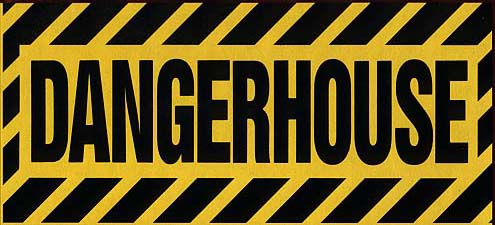
CONTINUED FROM
PAGE ONE
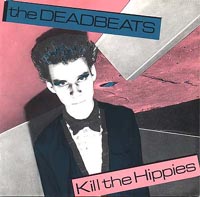 DEADBEATS ~ Kill The Hippies + Deadbeat b/w
DEADBEATS ~ Kill The Hippies + Deadbeat b/w
Brainless + Final Ride EP
(IQ-29 — released July 1978)
Scott Guerin: vox
Geza X: guitar
Pat Delaney: sax
Pasquale Amadeo: bass
Shaun Guerin: drums
DB: The musicianship of the young men who comprised the Deadbeats
was a joy to behold. Scott Guerin and his brother Shaun played as extensions of
the same self, and the band also served to unleash Geza X and Pat Delaney on the
world. Their stage act musically and visually confounded every cliché and
preconception about what "punk rock" meant. Their unique, driving sound consisted
of treated sax and fuzz guitar layered over flawlessly executed intricate rhythm
patterns.
Octavio Pretentious: I'm the cat who designed all those Deadbeats
flyers that are probably still hanging on your wall. I first came into contact with
the band through Cathie Deadbeat. She was the singer's girlfriend and did the band's
makeup. You might even say she was a silent co-conspirator in their musical/non-musical
assault on the L.A scene. She helped define the Deadbeat look and, brother, I'll
tell you the Deadbeats looked like no other band. At least not until the Dickies
got an eyeful of them. They shared a bill at the Masque. The Dickies showed up in
your typical T-shirt and jeans and did Ramones and Sex Pistols covers. (See Slash
#6 for proof...a picture's worth a thousand words). The Deadbeats came on and did
the Deadbeats. No more T-shirts and jeans for the Dickies.
Bands may have tried to cop their look, but nobody could cop their sound. Hell,
maybe nobody wanted to. On one flyer Brendan Mullen described the band as Bill Haley
meets Captain Beefheart in the Theater of the Absurd. Another critic stated that
they wanted to confuse. Untrue, untrue. It is my never-so-humble belief that they
wanted the masses to share in the joke, but their audiences were just too stupid
to get it.
Still, anyway you slice it, the Deadbeats were different. The bass player was a
gibbering idiot, but boy could he play. (Some say this was an act.) Slash
magazine called the sax player a poindexter squawking on a horn. They had an androgynous
drummer named Shaun. (Geddit? Could be a girl's or a boy's name). He got several
offers to join all-girl bands. (No, not the Go-Go's.) According to Geza, punk boys
secretly fantasized about him, never knowing "it" was a boy. One even claimed his
roommate had wet dreams over him. Basic Black magazine called the singer
a cross between David Bowie and Felix Unger. Go figure!?!? And what can you say
about Geza X? A grown man performing radical psychodrama on himself nightly in front
of a live audience. Needless to say, mental illness prevailed.
Unfortunately most people never got to witness this spectacle as the band never
made it out of L.A. One rumour has it that Geza's mommy (the real one) wouldn't
let him leave the city. Jeez, if you had a son like Geza, would you encourage him
to stay at home?
Scott Guerin: If not for a string of chance events the Deadbeats
may never have come into existence. My brother was asked to play drums for a band
called The Whores for the battle of the bands sequence in Cheech and Chong's
Up In Smoke movie. Except he
went and got himself grounded for cutting class too much and couldn't do it. So
I filled in for him. This lineup was scheduled to play the Whisky but then the
singer was forced to back out under the advice of his lawyer. It seems he was involved
in a lawsuit with the Whisky so playing there would constitute a conflict of interest.
There was only one course of action to take. I moved to vocals and my brother was
brought back to fill the drum slot. For me as a singer this was literally on-the-job
training as I had never even thought about singing before and truthfully was pretty
awful. After a few sporadic shows our guitarist Hilary Haines up and quit and moved
to San Francisco. Pat Delaney and I decided to change the name of the band to the
Deadbeats.
Nickey Beat (drummer for the Weirdos) had the fucking nerve to recommend one Geza
X to us and against better judgement we listened. Geza had just been booted out
of the Bags for farting out of key or something equally criminal. I may have been
responsible for the original sound and concept for the band but the addition of
Geza gave us a rawer, harder edge than we ever had before.
Now as for the breakup of the band, it was down to the usual clash of egos and an
over-dependence on substances by certain members that eventually caused the band
to implode.
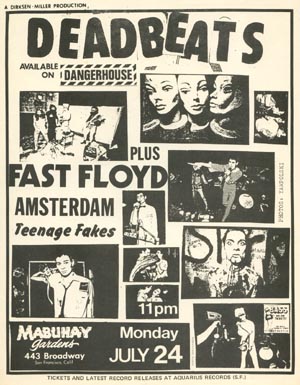 Geza X: Besides the musical sophistication, the best thing about
the Deadbeats was the staging. There were no bands doing elaborate things with
costumes and props in the early punk scene and we did amazing visuals. Scott was
the weirdest dresser on the scene, someone who might wear an impeccable chef's
outfit to a gig or even a party; and he had a complete collection of those novelty
items you order from the back of comic books, like fake dog doo and whoopee cushions.
Some people mistook his style for Glitter and that was a no-no in the early days
but the cool people all got that it was dada.
Geza X: Besides the musical sophistication, the best thing about
the Deadbeats was the staging. There were no bands doing elaborate things with
costumes and props in the early punk scene and we did amazing visuals. Scott was
the weirdest dresser on the scene, someone who might wear an impeccable chef's
outfit to a gig or even a party; and he had a complete collection of those novelty
items you order from the back of comic books, like fake dog doo and whoopee cushions.
Some people mistook his style for Glitter and that was a no-no in the early days
but the cool people all got that it was dada.
One time at the Masque, as an intro to the song "Brainless", we wheeled out a mannequin
on a cart and proceeded to cut its skull open to reveal several handfuls of blood
drenched cow's brains, some of which ended up on an unsuspecting audience. Somehow
the photographs of that show came out with that magic glow you see in the finest
performance art books and we used them on many a flyer.
Another time before a show at the Whisky, we were at the beach and there had been
a major storm the night before. I collected a huge mass of abnormally large seaweed
and washed it off so it was slimy but clean. During the show that night, I went
in to the "Mean Mr. Mommyman" routine to the usual heckling from the "real" punks
(the lizard brains who used to come on weekends and show how cool they were). So
I ran behind my amp and grabbed two hefty trash bags, from which I heaved a lot
of seaweed right into the audience. At first they thought it was rubber, but when
it made contact and the smell got around, panic set in and everyone moved way back
so there was a large open space in the front. I said something smartarse like "Oh,
did it get on you? Just wait a minute..." and ran up the stairs to the backstage
area where I had hidden the piece de resistance from everyone (including the band).
I came back down the stairs thump, thump, thump dragging a single, perfectly shaped
seaweed bulb, the kind with a pointy ball and fins, except this was the granddaddy
of all life on earth, being about 11 feet long and about 3 feet wide. To everyone's
fascinated revulsion, I chucked it into the slam pit where it exploded in a pile
of goo. There was a moment of absolute silence after that. Somehow, that stands
out as one of the most hilarious moments of my life.
Pasquale Amodeo: I've always thought it appropriate that I'd be
lobotomized before gigs and transformed into a babbling idiot savant bassist unable
to pronounce one single word yet play this incredibly intense music.
Shaun Guerin: The scene was so new and experimental and it didn't
matter if anyone could really play their instruments. I remember being at the Masque
and watching everyone slamming against each other, having a good time, never realizing
what kind of movement they were involved in. It was just something to do.
I'll never forget the time my brother, Scott, kicked Geza off the stage at the Whisky
for doing really corny rock star poses, and the cable, still attached to his amp,
pulled it off the speaker cabinet. It came crashing to the ground yet still kept
on working. Geza continued to play from down in the audience as though nothing had
happened.
BMF: Black, clear, and yellow
vinyl issued. Clear vinyl is the most elusive. No picture sleeve variations.
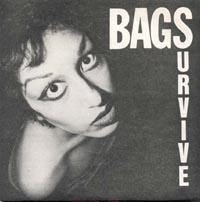 BAGS ~ Survive b/w Babylonian Gorgon 7in.
BAGS ~ Survive b/w Babylonian Gorgon 7in.
(BAG199 — released December 1978)
Alice Bag: vox
Rob Ritter: guitar
Craig Bag: guitar
Pat Bag: bass
Terry "Dad" Bag: drums
DB: The first time I saw the Bags at the Whisky I was a little
impaired, but I seem to recall Joe Nanini drumming with an athletic support on his
face. He was quickly sacked and replaced with the stone-faced Terry "Dad" Bag. Suffice
it to say that no one who ever saw Alice Bag in action will forget it in this lifetime.
With Pat Bag on bass, and the duelin' guitars of the late Rob Ritter and Craig Bag,
the Bags generated conflict in their stage shows, and understood the art of arranging
like thrash bands never did.
Geza X did an amazing job on putting the Bags together. There were some real severe
technical problems caused by the machine bias of the studio which we fixed up in the
mix. The Bags just played their hearts out, you could really tell. I think that's
absolutely the best thing we ever put out, I still get shivers down my brainstem when
listening to "Survive". Again I don't think it sold more than about 1200 copies
at that time and then they asked us to pull it. At this point just about every band
asked us to pull the recording after 1200-1500 records... the Alley Cats, Weirdos.
BMF: Black vinyl only. Some copies have labels
reversed with overlayed stickers with correct song titles.
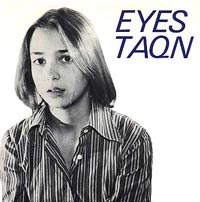 EYES ~ T.A.Q.N. b/w Topological Lies 7in.
EYES ~ T.A.Q.N. b/w Topological Lies 7in.
(IZE45 — released February 1979)
Joe Ramirez: guitar, lead vox
Jimmy Leach: bass, vox
Joe Nanini: drums
David Brown: organ
DB: About this time, maybe late 1978, I joined this band called
the EYES. Charlotte Caffey had been playing bass and I think keyboards and stuff.
She left to go form the Go-Go's. As a matter of fact Belinda Carlisle and Jane Wiedlin
got their first actual stage experience as members of Randy's Blackettes...I know
this, I remember this, I have photos to prove it. You have to kind of laugh when
you think of these people sleeping with baseball players now. Talk about seeing
life from both sides. So the Eyes basically replaced her with two people, me and
Jimmy Leach, and then we did a record called TAQN, Take A Quaalude Now, a very
tongue-in-cheek anti-drug song. I guess it speaks for itself.
Joe Ramirez, the leader of the Eyes, was a cerebral master of the unexpected lyric
in front of the musical conventions of punk rock. His musical concept fit into the
Wire keep-'em-coming-too-fast-to-know groove, and the lyrics he wrote with John
Richey were way over most people's heads.
BMF: Black vinyl only. No variations.
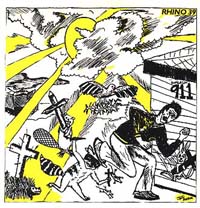 RHINO 39 ~ Xerox/No Compromise b/w Prolixin Stomp 7in.
RHINO 39 ~ Xerox/No Compromise b/w Prolixin Stomp 7in.
(RH39 — released 1979)
Dave Dacron: vox
Larry Parrott: guitar
Mark Malone: bass
Tim Carhart: drums
DB: Then we put out a single by Rhino 39, named for a famous virus
on the Lysol can. They were a group of high school kids from Long Beach who passed
as a powerful and clever punk band. They were also friends of ours, we went a long
distance every weekend to watch them for a couple of months, and Randy was interested
in doing a record with them. Just really great kids — demented and fun-loving
in a way I admired. Their manic speed of delivery bordered on speed metal, but these
kids had taste and talent to burn, and there was never the slightest tinge of hatred
in their message. They continued for years afterwards, but things were calmer after
singer Dave Dacron was killed in a car crash shortly before graduation, truly a case
of unrealized but very great potential.
BMF: Black vinyl only. No variations. Perhaps
the toughest standard issue to find on the label.
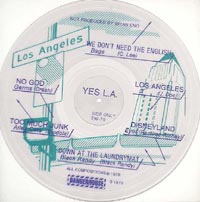 YES L.A. compilation 12in.
YES L.A. compilation 12in.
(EW79 — released 1979)
BAGS ~ We Don't Need The English
EYES ~ Disneyland
ALLEY CATS ~ Too Much Junk
X ~ Los Angeles
BLACK RANDY ~ Down At The Laundrymat
GERMS ~ No God
DB: At this point we were trying to come up with some 12" single
to do. I pitched the idea of doing a clear silkscreened album with two colors and
suddenly there were 2000 records sitting in my living room with a silkscreen put
together. We actually did it, we did screen prints for about a week and a half,
all of them by hand. I would say only about 20 or 30 were screwed up.
It was a very successful piece of design by Pat, very professional artwork. So I
was proud to be doing my part on the production end.
There had been an album done like that in one color, I didn't necessarily cook up
the complete idea of doing that. We wanted to do a picture disc very badly, or
something that would have saleability, something that would move all of them right
away. But we knew that most of the technologies for that at that time were really
kind of crappy. You got bad sound quality. So the Yes L.A. idea, not putting
music on one side and trashing that side by silkscreening it, meant we could concentrate
on the selection of songs and the mastering, or so we thought.
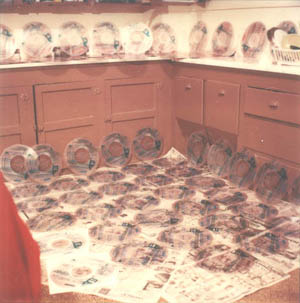 So, at that point we were kind of feuding with Geza X a little bit, because he was
screaming about the work we had done with the Deadbeats and the Bags. I guess at
that point the Bags were national, but the Deadbeats had never made squat because
they proceeded to disband just about the day their record came out and nobody really
wanted to buy any records from a band that had broken up anyway. We were kind of
feuding with him about some of his production techniques, which at the time was
squirrelly because he's such a creative guy and he'd try anything. So we had taken
the tapes of the Germs that Slash magazine owned and remixed them the way we would
do it — sort of the Geza way. It was interesting to compare. I admire Geza very
much for the work he's done over the years and I understand he runs an outstanding
studio now, but I haven't seen him in years.
So, at that point we were kind of feuding with Geza X a little bit, because he was
screaming about the work we had done with the Deadbeats and the Bags. I guess at
that point the Bags were national, but the Deadbeats had never made squat because
they proceeded to disband just about the day their record came out and nobody really
wanted to buy any records from a band that had broken up anyway. We were kind of
feuding with him about some of his production techniques, which at the time was
squirrelly because he's such a creative guy and he'd try anything. So we had taken
the tapes of the Germs that Slash magazine owned and remixed them the way we would
do it — sort of the Geza way. It was interesting to compare. I admire Geza very
much for the work he's done over the years and I understand he runs an outstanding
studio now, but I haven't seen him in years.
Let's see, the other cuts... the Black Randy cut was something we'd dragged up from
the old house on Carlton way back in the beginning when Pat was living in Hollywood.
This was the first time X's "Los Angeles" appeared, also from their first sessions.
Okay, the Bags, that was the first thing of theirs. Well, the single came out about
the same time.
BMF: 2000 one-sided discs pressed on clear vinyl
(with the exception of the non-silkscreened black vinyl test pressings). The background
graphic is green on all copies. Text colors include: blue, green, red, black, and pink
(exceedingly rare). Copies exist with text only, graphic only, and no silkscreen. Yes L.A.
marks a highpoint of creativity and quality for the label, unmatched by any label
since.
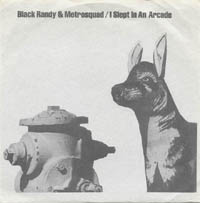 BLACK RANDY & THE METROSQUAD ~
BLACK RANDY & THE METROSQUAD ~
I Slept In An Arcade b/w Give It Up Or Turn It Loose 7in.
(KY724 — released July 1979)
DB: At this point things started to get a little nasty with Slash
magazine. I can remember, Claude Bessy (Kickboy Face) had been invited to the Green
Frog show as sort of like a celebrity guest. He went out there with Randy, and this
was a fairly common thing, and got Randy so fucking loaded that he couldn't stand
up. I have tapes, and you can just hear Randy rolling around. We had paid to have
this eight track mobile unit come and record the thing. Claude managed to single-handedly
undo the whole thing. He was handing Randy poppers on the stage at the show and
stuff like that. The next morning he sat down and wrote this very scathing review
of how terrible the show was. Which, of course, it had been, I suppose. It's bad
to blame it totally on Randy but why not? He's dead, I can say anything I want to.
[editorial note: Claude's dead now, too, so let's just blame both of 'em and be
done with it.] It was definitely Randy's chance to shine and he blew it. Following
that up I guess we released the Black Randy album Pass The Dust, I Think I'm Bowie.
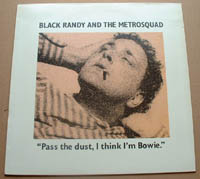 BLACK RANDY & THE METROSQUAD ~
BLACK RANDY & THE METROSQUAD ~
Pass The Dust, I Think I'm Bowie LP
(PCP725 — released July 1979)
Later about the same time we were in New York as guests of Steve from the Mudd Club
for about a week. Which was very strange because the New York audience didn't really
like us at all. He had paid this huge sum of money to fly us all out there and pay
for all these expenses and shit, and we just made his life totally miserable the
whole time. Joe, Randy, my brother and I just set upon the poor man, and he must
have just hated any mention of us after that. In any case, the New York audience
was totally mystified by the album. I listen to it now and I guess I can understand
their point. There's a lot of different stuff going on for sure. I can't explain
most of it, musically or any other way.
Then at this point Pat Garrett just iced himself out of the picture because he couldn't
stand Randy's bullshit anymore. He just got more involved with his marriage and
family life, and job and everything. I think the only thing we did after that was
a movie made by, what's that idiot's name, from Ode Records? Produced the Mamas
and the Papas? Lou Adler. He had us flown up to Vancouver and pretend to be punk
rock musicians and lipsync to "I Slept In An Arcade" in this movie he was making
about punk rock. Randy actually got this very nifty role where he became the bad
guy in the movie, which was totally appropriate because he wanted to be the bad
guy. It was originally supposed to be All Washed Up.
When it was finally released, it was released on cable to Canada and then finally
on video, although I've never been able to find it, it was called Ladies And Gentlemen, The Fabulous Stains.
BMF: Black vinyl only on both of the above.
The LP includes an inner sleeve with essential BR lyrics.
DB: After that we were pretty much out of business. We couldn't
con anybody. Pat wasn't interested anymore. Randy had a severe drug and alcohol
problem, and I just wasn't able to do it all myself, and nobody liked us anymore
anyway. We were considered real scum. I would go on for years after that reading
interviews with people who were harmlessly enough giving these interviews, then
there would be something awful about me in the middle of it. This must have gone
on until 1983. Finally, I just quit reading the L.A. Times County section
altogether.
TY: So from that point you pretty much disappeared from the L.A.
punk scene?
DB: There was no more scene. That was the other problem. There
was a thrash scene, kind of what I think of as an Orange County skinhead sound that
was really big at the time.
TY: Black Flag and all that stuff was starting.
DB: I'm not talking about Black Flag, but that's certainly true
of all those other bands.
TY: Middle Class?
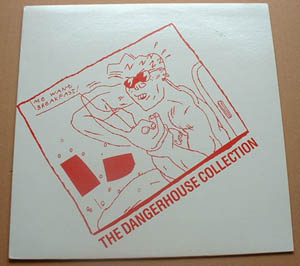 DB: Not them, they had so much taste going for them. Now Poshboy
is back... talk about someone who refuses to die. A couple of years ago it occurred
to me that as many bootlegs appeared of our stuff, we really deserved to think about
a proper reissue. Then of course along came CD's. Now, working with Lisa Fancher
of Frontier, it's been an incredibly positive experience compared to all the ones
that came before. I just feel exonerated about the whole thing. I don't feel like
an asshole anymore for doing it. I feel like if I hadn't done it then none of those
records or sounds would even be remembered today. I don't care what people say about
me. It's just worth it — losing all the money that I did, having people say
all the shit about the things that I did, just to have those recordings right now
is worth it ten times over. So I'm really glad about that.
DB: Not them, they had so much taste going for them. Now Poshboy
is back... talk about someone who refuses to die. A couple of years ago it occurred
to me that as many bootlegs appeared of our stuff, we really deserved to think about
a proper reissue. Then of course along came CD's. Now, working with Lisa Fancher
of Frontier, it's been an incredibly positive experience compared to all the ones
that came before. I just feel exonerated about the whole thing. I don't feel like
an asshole anymore for doing it. I feel like if I hadn't done it then none of those
records or sounds would even be remembered today. I don't care what people say about
me. It's just worth it — losing all the money that I did, having people say
all the shit about the things that I did, just to have those recordings right now
is worth it ten times over. So I'm really glad about that.
TY: So there was an album that came out a few years back called
Dangerhouse Collection, that was a bootleg?
DB: I think it was Me Want Breakfast, that was definitely
a bootleg. Some dude in New York did that. I would get upset but he did such a shitty
job that, if anything, it just whet people's appetite for the real thing. Maybe
he just helped keep the myth alive. I'll never find out who it was, but I've heard
tales.
Mind-blowing photos of the Dangerhouse roster by Scott Lindgren are available through
Empire Of The Image



CONTACT: Break My Face


 DEADBEATS ~ Kill The Hippies + Deadbeat b/w
DEADBEATS ~ Kill The Hippies + Deadbeat b/w Geza X: Besides the musical sophistication, the best thing about
the Deadbeats was the staging. There were no bands doing elaborate things with
costumes and props in the early punk scene and we did amazing visuals. Scott was
the weirdest dresser on the scene, someone who might wear an impeccable chef's
outfit to a gig or even a party; and he had a complete collection of those novelty
items you order from the back of comic books, like fake dog doo and whoopee cushions.
Some people mistook his style for Glitter and that was a no-no in the early days
but the cool people all got that it was dada.
Geza X: Besides the musical sophistication, the best thing about
the Deadbeats was the staging. There were no bands doing elaborate things with
costumes and props in the early punk scene and we did amazing visuals. Scott was
the weirdest dresser on the scene, someone who might wear an impeccable chef's
outfit to a gig or even a party; and he had a complete collection of those novelty
items you order from the back of comic books, like fake dog doo and whoopee cushions.
Some people mistook his style for Glitter and that was a no-no in the early days
but the cool people all got that it was dada. BAGS ~ Survive b/w Babylonian Gorgon 7in.
BAGS ~ Survive b/w Babylonian Gorgon 7in. EYES ~ T.A.Q.N. b/w Topological Lies 7in.
EYES ~ T.A.Q.N. b/w Topological Lies 7in. RHINO 39 ~ Xerox/No Compromise b/w Prolixin Stomp 7in.
RHINO 39 ~ Xerox/No Compromise b/w Prolixin Stomp 7in. YES L.A. compilation 12in.
YES L.A. compilation 12in. So, at that point we were kind of feuding with Geza X a little bit, because he was
screaming about the work we had done with the Deadbeats and the Bags. I guess at
that point the Bags were national, but the Deadbeats had never made squat because
they proceeded to disband just about the day their record came out and nobody really
wanted to buy any records from a band that had broken up anyway. We were kind of
feuding with him about some of his production techniques, which at the time was
squirrelly because he's such a creative guy and he'd try anything. So we had taken
the tapes of the Germs that Slash magazine owned and remixed them the way we would
do it — sort of the Geza way. It was interesting to compare. I admire Geza very
much for the work he's done over the years and I understand he runs an outstanding
studio now, but I haven't seen him in years.
So, at that point we were kind of feuding with Geza X a little bit, because he was
screaming about the work we had done with the Deadbeats and the Bags. I guess at
that point the Bags were national, but the Deadbeats had never made squat because
they proceeded to disband just about the day their record came out and nobody really
wanted to buy any records from a band that had broken up anyway. We were kind of
feuding with him about some of his production techniques, which at the time was
squirrelly because he's such a creative guy and he'd try anything. So we had taken
the tapes of the Germs that Slash magazine owned and remixed them the way we would
do it — sort of the Geza way. It was interesting to compare. I admire Geza very
much for the work he's done over the years and I understand he runs an outstanding
studio now, but I haven't seen him in years. BLACK RANDY & THE METROSQUAD ~
BLACK RANDY & THE METROSQUAD ~ BLACK RANDY & THE METROSQUAD ~
BLACK RANDY & THE METROSQUAD ~ DB: Not them, they had so much taste going for them. Now Poshboy
is back... talk about someone who refuses to die. A couple of years ago it occurred
to me that as many bootlegs appeared of our stuff, we really deserved to think about
a proper reissue. Then of course along came CD's. Now, working with Lisa Fancher
of Frontier, it's been an incredibly positive experience compared to all the ones
that came before. I just feel exonerated about the whole thing. I don't feel like
an asshole anymore for doing it. I feel like if I hadn't done it then none of those
records or sounds would even be remembered today. I don't care what people say about
me. It's just worth it — losing all the money that I did, having people say
all the shit about the things that I did, just to have those recordings right now
is worth it ten times over. So I'm really glad about that.
DB: Not them, they had so much taste going for them. Now Poshboy
is back... talk about someone who refuses to die. A couple of years ago it occurred
to me that as many bootlegs appeared of our stuff, we really deserved to think about
a proper reissue. Then of course along came CD's. Now, working with Lisa Fancher
of Frontier, it's been an incredibly positive experience compared to all the ones
that came before. I just feel exonerated about the whole thing. I don't feel like
an asshole anymore for doing it. I feel like if I hadn't done it then none of those
records or sounds would even be remembered today. I don't care what people say about
me. It's just worth it — losing all the money that I did, having people say
all the shit about the things that I did, just to have those recordings right now
is worth it ten times over. So I'm really glad about that.![]()
![]()
![]()